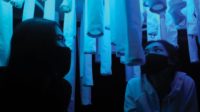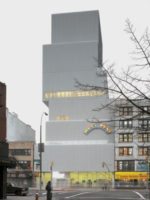SANAA Designs Artificial Landscape

Photo © Hisao Suzuki

Photo © EPFL | Alain Herzog

Photo © Hisao Suzuki

Photo © Hisao Suzuki

Photo © Hisao Suzuki

Photo © Hisao Suzuki

Photo © EPFL | Alain Herzog







Architects & Firms
Designed by SANAA, the Japanese firm headed by Kazuyo Sejima and Ryue Nishizawa, the 398,000-square-foot library and campus hub presents visitors with a concrete floor that slopes and swells like the surrounding Swiss landscape. People with mobility problems or those just feeling tired can take specially designed “inclined elevators,” glass boxes adapted from standard lift design.
The architects’ goal was to create one fluid space where students and researchers from the school’s various disciplines (science, engineering, technology, and architecture) can mingle in an environment with almost no traditional partitions. Instead of using steps, stairs, or walls, SANAA separated different functional areas by placing them in floor valleys or tucked between the five outdoor “patios” cut within the building’s rectangular footprint. These ovoid patios, which are surrounded by glazing, provide a variety of landscaped places for socializing and bring daylight into all parts of the one-story facility.
“During the competition, we studied many schemes—such as stacking the programs or scattering them in separate buildings,” recalls Yumiko Yamada, the project architect for SANAA. “But we decided that a one-room space was the best response to the client’s brief,” explains Yamada. The architects then focused on organizing the various functions so that “each is separated and connected at the same time.”
SANAA worked with structural engineer Matsuro Sasaki during the initial planning phase and with Bollinger + Grohmann and Walther Mory Maier throughout the entire project to design the building’s concrete floor as a set of shells supported by 11 arches stayed by underground cables. The arches range in length from 98 to 295 feet. Workers poured the concrete for two straight weeks into 4,000 digitally modeled wooden frameworks, using a global-positioning system to ensure precision. The lightweight roof made of wood and steel parallels the slopes and curves of the floor to create a single slice of space running throughout the building
Because the arches raise much of the building off the ground, the architects were able to create outdoor space underneath the structure. Their goal was to use this space to create a continuum with the landscape of the campus and the city.
The learning center brings together a 500,000-volume, open-stack library, a 600-seat auditorium, places to study, and facilities for dining and socializing. A public-private partnership involving the country’s federal government and corporate sponsors such as Rolex, Credit Suisse, Nestlé, Logitech, Novartis, and others provided funding for the project. “The Rolex Learning Center exemplifies our university as a place where traditional boundaries between disciplines are broken down,” states Patrick Aebischer, president of EPFL.
Editor’s Note: This story was updated on March 23, 2010, to include the engineering firms Bollinger + Grohmann and Walter Mory Maier.










